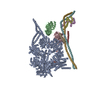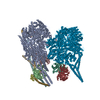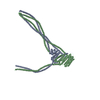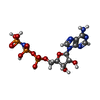+ Open data
Open data
- Basic information
Basic information
| Entry | Database: PDB / ID: 8ptk | ||||||||||||
|---|---|---|---|---|---|---|---|---|---|---|---|---|---|
| Title | Composite structure of Dynein-Dynactin-JIP3-LIS1 | ||||||||||||
 Components Components |
| ||||||||||||
 Keywords Keywords | MOTOR PROTEIN / Dynein / AAA-Atpase / p150 / LIS1 / Dynactin / JIP3 | ||||||||||||
| Function / homology |  Function and homology information Function and homology informationRHOD GTPase cycle / Factors involved in megakaryocyte development and platelet production / intracellular transport of viral protein in host cell / corpus callosum morphogenesis / nitric-oxide synthase inhibitor activity / microtubule cytoskeleton organization involved in establishment of planar polarity / ameboidal-type cell migration / establishment of planar polarity of embryonic epithelium / secretory vesicle / 1-alkyl-2-acetylglycerophosphocholine esterase complex ...RHOD GTPase cycle / Factors involved in megakaryocyte development and platelet production / intracellular transport of viral protein in host cell / corpus callosum morphogenesis / nitric-oxide synthase inhibitor activity / microtubule cytoskeleton organization involved in establishment of planar polarity / ameboidal-type cell migration / establishment of planar polarity of embryonic epithelium / secretory vesicle / 1-alkyl-2-acetylglycerophosphocholine esterase complex / retrograde axonal transport of mitochondrion / Regulation of actin dynamics for phagocytic cup formation / EPHB-mediated forward signaling / Adherens junctions interactions / VEGFA-VEGFR2 Pathway / Cell-extracellular matrix interactions / RHO GTPases Activate WASPs and WAVEs / MAP2K and MAPK activation / deoxyribonuclease inhibitor activity / negative regulation of DNA strand resection involved in replication fork processing / UCH proteinases / Gap junction degradation / Formation of annular gap junctions / RHOF GTPase cycle / centriolar subdistal appendage / Clathrin-mediated endocytosis / Formation of the dystrophin-glycoprotein complex (DGC) / dynactin complex / positive regulation of neuromuscular junction development / maintenance of centrosome location / negative regulation of phosphorylation / centriole-centriole cohesion / platelet activating factor metabolic process / transport along microtubule / intraciliary retrograde transport / visual behavior / Regulation of PLK1 Activity at G2/M Transition / Loss of Nlp from mitotic centrosomes / Loss of proteins required for interphase microtubule organization from the centrosome / Anchoring of the basal body to the plasma membrane / AURKA Activation by TPX2 / F-actin capping protein complex / WASH complex / radial glia-guided pyramidal neuron migration / acrosome assembly / microtubule anchoring at centrosome / central region of growth cone / Recruitment of mitotic centrosome proteins and complexes / cerebral cortex neuron differentiation / dynein light chain binding / establishment of centrosome localization / microtubule sliding / anterograde axonal protein transport / ventral spinal cord development / dynein heavy chain binding / positive regulation of cytokine-mediated signaling pathway / Activation of BIM and translocation to mitochondria / motile cilium assembly / positive regulation of embryonic development / microtubule organizing center organization / interneuron migration / layer formation in cerebral cortex / retromer complex / cytoskeleton-dependent cytokinesis / ciliary tip / astral microtubule / microtubule plus-end / auditory receptor cell development / nuclear membrane disassembly / cellular response to cytochalasin B / Intraflagellar transport / positive regulation of intracellular transport / cortical microtubule organization / MAP-kinase scaffold activity / negative regulation of nitric oxide biosynthetic process / positive regulation of microtubule nucleation / positive regulation of dendritic spine morphogenesis / regulation of transepithelial transport / reelin-mediated signaling pathway / myeloid leukocyte migration / regulation of metaphase plate congression / morphogenesis of a polarized epithelium / structural constituent of postsynaptic actin cytoskeleton / positive regulation of spindle assembly / barbed-end actin filament capping / melanosome transport / JUN kinase binding / protein localization to adherens junction / establishment of spindle localization / regulation of G protein-coupled receptor signaling pathway / dense body / Neutrophil degranulation / postsynaptic actin cytoskeleton / stereocilium / osteoclast development / Tat protein binding / coronary vasculature development / microtubule plus-end binding / non-motile cilium assembly / microtubule-dependent intracellular transport of viral material towards nucleus Similarity search - Function | ||||||||||||
| Biological species |  Homo sapiens (human) Homo sapiens (human) | ||||||||||||
| Method | ELECTRON MICROSCOPY / single particle reconstruction / cryo EM / Resolution: 10 Å | ||||||||||||
 Authors Authors | Singh, K. / Lau, C.K. / Manigrasso, G. / Gassmann, R. / Carter, A.P. | ||||||||||||
| Funding support |  United Kingdom, European Union, 3items United Kingdom, European Union, 3items
| ||||||||||||
 Citation Citation |  Journal: Science / Year: 2024 Journal: Science / Year: 2024Title: Molecular mechanism of dynein-dynactin complex assembly by LIS1. Authors: Kashish Singh / Clinton K Lau / Giulia Manigrasso / José B Gama / Reto Gassmann / Andrew P Carter /   Abstract: Cytoplasmic dynein is a microtubule motor vital for cellular organization and division. It functions as a ~4-megadalton complex containing its cofactor dynactin and a cargo-specific coiled-coil ...Cytoplasmic dynein is a microtubule motor vital for cellular organization and division. It functions as a ~4-megadalton complex containing its cofactor dynactin and a cargo-specific coiled-coil adaptor. However, how dynein and dynactin recognize diverse adaptors, how they interact with each other during complex formation, and the role of critical regulators such as lissencephaly-1 (LIS1) protein (LIS1) remain unclear. In this study, we determined the cryo-electron microscopy structure of dynein-dynactin on microtubules with LIS1 and the lysosomal adaptor JIP3. This structure reveals the molecular basis of interactions occurring during dynein activation. We show how JIP3 activates dynein despite its atypical architecture. Unexpectedly, LIS1 binds dynactin's p150 subunit, tethering it along the length of dynein. Our data suggest that LIS1 and p150 constrain dynein-dynactin to ensure efficient complex formation. | ||||||||||||
| History |
|
- Structure visualization
Structure visualization
| Structure viewer | Molecule:  Molmil Molmil Jmol/JSmol Jmol/JSmol |
|---|
- Downloads & links
Downloads & links
- Download
Download
| PDBx/mmCIF format |  8ptk.cif.gz 8ptk.cif.gz | 4.4 MB | Display |  PDBx/mmCIF format PDBx/mmCIF format |
|---|---|---|---|---|
| PDB format |  pdb8ptk.ent.gz pdb8ptk.ent.gz | Display |  PDB format PDB format | |
| PDBx/mmJSON format |  8ptk.json.gz 8ptk.json.gz | Tree view |  PDBx/mmJSON format PDBx/mmJSON format | |
| Others |  Other downloads Other downloads |
-Validation report
| Summary document |  8ptk_validation.pdf.gz 8ptk_validation.pdf.gz | 2.4 MB | Display |  wwPDB validaton report wwPDB validaton report |
|---|---|---|---|---|
| Full document |  8ptk_full_validation.pdf.gz 8ptk_full_validation.pdf.gz | 2.4 MB | Display | |
| Data in XML |  8ptk_validation.xml.gz 8ptk_validation.xml.gz | 548.4 KB | Display | |
| Data in CIF |  8ptk_validation.cif.gz 8ptk_validation.cif.gz | 987.9 KB | Display | |
| Arichive directory |  https://data.pdbj.org/pub/pdb/validation_reports/pt/8ptk https://data.pdbj.org/pub/pdb/validation_reports/pt/8ptk ftp://data.pdbj.org/pub/pdb/validation_reports/pt/8ptk ftp://data.pdbj.org/pub/pdb/validation_reports/pt/8ptk | HTTPS FTP |
-Related structure data
| Related structure data |  17873MC  8pqvC  8pqwC  8pqyC  8pqzC  8pr0C  8pr1C  8pr2C  8pr3C  8pr4C  8pr5C M: map data used to model this data C: citing same article ( |
|---|---|
| Similar structure data | Similarity search - Function & homology  F&H Search F&H Search |
- Links
Links
- Assembly
Assembly
| Deposited unit | 
|
|---|---|
| 1 |
|
- Components
Components
-Protein , 8 types, 19 molecules 1234ABCDEFGIHJKLUXx
| #1: Protein | Mass: 46709.984 Da / Num. of mol.: 4 Source method: isolated from a genetically manipulated source Source: (gene. exp.)  Homo sapiens (human) / Gene: PAFAH1B1, LIS1, MDCR, MDS, PAFAHA / Production host: Homo sapiens (human) / Gene: PAFAH1B1, LIS1, MDCR, MDS, PAFAHA / Production host:  #2: Protein | Mass: 42670.688 Da / Num. of mol.: 8 / Source method: isolated from a natural source / Source: (natural)  #3: Protein | | Mass: 41782.660 Da / Num. of mol.: 1 / Source method: isolated from a natural source / Source: (natural)  #4: Protein | | Mass: 46250.785 Da / Num. of mol.: 1 / Source method: isolated from a natural source / Source: (natural)  #5: Protein | | Mass: 33059.848 Da / Num. of mol.: 1 / Source method: isolated from a natural source / Source: (natural)  #6: Protein | | Mass: 30669.768 Da / Num. of mol.: 1 / Source method: isolated from a natural source / Source: (natural)  #10: Protein | | Mass: 20703.910 Da / Num. of mol.: 1 / Source method: isolated from a natural source / Source: (natural)  #12: Protein | Mass: 65975.398 Da / Num. of mol.: 2 Source method: isolated from a genetically manipulated source Source: (gene. exp.)  Homo sapiens (human) / Gene: MAPK8IP3, JIP3, KIAA1066 / Production host: Homo sapiens (human) / Gene: MAPK8IP3, JIP3, KIAA1066 / Production host:  |
|---|
-Dynactin subunit ... , 5 types, 10 molecules MNPQORSTWY
| #7: Protein | Mass: 44704.414 Da / Num. of mol.: 4 / Source method: isolated from a natural source / Source: (natural)  #8: Protein | Mass: 21192.477 Da / Num. of mol.: 2 / Source method: isolated from a natural source / Source: (natural)  #9: Protein | Mass: 142015.484 Da / Num. of mol.: 2 / Source method: isolated from a natural source / Source: (natural)  #11: Protein | | Mass: 20150.533 Da / Num. of mol.: 1 / Source method: isolated from a natural source / Source: (natural)  #13: Protein | | Mass: 52920.434 Da / Num. of mol.: 1 / Source method: isolated from a natural source / Source: (natural)  |
|---|
-Dynein light chain ... , 3 types, 12 molecules abdiklvystwz
| #14: Protein | Mass: 10381.899 Da / Num. of mol.: 4 Source method: isolated from a genetically manipulated source Source: (gene. exp.)  Homo sapiens (human) / Gene: DYNLL1, DLC1, DNCL1, DNCLC1, HDLC1 / Production host: Homo sapiens (human) / Gene: DYNLL1, DLC1, DNCL1, DNCLC1, HDLC1 / Production host:  #18: Protein | Mass: 12461.996 Da / Num. of mol.: 4 Source method: isolated from a genetically manipulated source Source: (gene. exp.)  Homo sapiens (human) / Gene: DYNLT1 / Production host: Homo sapiens (human) / Gene: DYNLT1 / Production host:  #19: Protein | Mass: 10934.576 Da / Num. of mol.: 4 Source method: isolated from a genetically manipulated source Source: (gene. exp.)  Homo sapiens (human) / Gene: DYNLRB1, BITH, DNCL2A, DNLC2A, ROBLD1, HSPC162 / Production host: Homo sapiens (human) / Gene: DYNLRB1, BITH, DNCL2A, DNLC2A, ROBLD1, HSPC162 / Production host:  |
|---|
-Cytoplasmic dynein 1 ... , 3 types, 12 molecules efmnghopjqru
| #15: Protein | Mass: 533055.125 Da / Num. of mol.: 4 / Mutation: R1567E, K1610E Source method: isolated from a genetically manipulated source Source: (gene. exp.)  Homo sapiens (human) / Gene: DYNC1H1, DHC1, DNCH1, DNCL, DNECL, DYHC, KIAA0325 / Production host: Homo sapiens (human) / Gene: DYNC1H1, DHC1, DNCH1, DNCL, DNECL, DYHC, KIAA0325 / Production host:  #16: Protein | Mass: 68442.141 Da / Num. of mol.: 4 Source method: isolated from a genetically manipulated source Source: (gene. exp.)  Homo sapiens (human) / Gene: DYNC1I2, DNCI2, DNCIC2 / Production host: Homo sapiens (human) / Gene: DYNC1I2, DNCI2, DNCIC2 / Production host:  #17: Protein | Mass: 54173.156 Da / Num. of mol.: 4 Source method: isolated from a genetically manipulated source Source: (gene. exp.)  Homo sapiens (human) / Gene: DYNC1LI2, DNCLI2, LIC2 / Production host: Homo sapiens (human) / Gene: DYNC1LI2, DNCLI2, LIC2 / Production host:  |
|---|
-Non-polymers , 5 types, 35 molecules 








| #20: Chemical | ChemComp-ADP / #21: Chemical | ChemComp-ATP / #22: Chemical | #23: Chemical | ChemComp-MG / #24: Chemical | ChemComp-ANP / |
|---|
-Details
| Has ligand of interest | Y |
|---|
-Experimental details
-Experiment
| Experiment | Method: ELECTRON MICROSCOPY |
|---|---|
| EM experiment | Aggregation state: PARTICLE / 3D reconstruction method: single particle reconstruction |
- Sample preparation
Sample preparation
| Component |
| ||||||||||||||||||||||||
|---|---|---|---|---|---|---|---|---|---|---|---|---|---|---|---|---|---|---|---|---|---|---|---|---|---|
| Source (natural) |
| ||||||||||||||||||||||||
| Source (recombinant) | Organism:  | ||||||||||||||||||||||||
| Buffer solution | pH: 7.2 | ||||||||||||||||||||||||
| Specimen | Embedding applied: NO / Shadowing applied: NO / Staining applied: NO / Vitrification applied: YES | ||||||||||||||||||||||||
| Vitrification | Cryogen name: ETHANE |
- Electron microscopy imaging
Electron microscopy imaging
| Experimental equipment |  Model: Titan Krios / Image courtesy: FEI Company |
|---|---|
| Microscopy | Model: FEI TITAN KRIOS |
| Electron gun | Electron source:  FIELD EMISSION GUN / Accelerating voltage: 300 kV / Illumination mode: FLOOD BEAM FIELD EMISSION GUN / Accelerating voltage: 300 kV / Illumination mode: FLOOD BEAM |
| Electron lens | Mode: BRIGHT FIELD / Nominal defocus max: 4000 nm / Nominal defocus min: 500 nm |
| Image recording | Electron dose: 53 e/Å2 / Film or detector model: GATAN K3 BIOQUANTUM (6k x 4k) |
- Processing
Processing
| EM software |
| ||||||||||||
|---|---|---|---|---|---|---|---|---|---|---|---|---|---|
| CTF correction | Type: PHASE FLIPPING AND AMPLITUDE CORRECTION | ||||||||||||
| 3D reconstruction | Resolution: 10 Å / Resolution method: OTHER / Num. of particles: 700290 / Symmetry type: POINT | ||||||||||||
| Atomic model building | PDB-ID: 7Z8G Accession code: 7Z8G / Source name: PDB / Type: experimental model |
 Movie
Movie Controller
Controller














 PDBj
PDBj







































